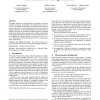Free Online Productivity Tools
i2Speak
i2Symbol
i2OCR
iTex2Img
iWeb2Print
iWeb2Shot
i2Type
iPdf2Split
iPdf2Merge
i2Bopomofo
i2Arabic
i2Style
i2Image
i2PDF
iLatex2Rtf
Sci2ools
IWMM
2010
Springer
2010
Springer
The economics of garbage collection
This paper argues that economic theory can improve our understanding of memory management. We introduce the allocation curve, as an analogue of the demand curve from microeconomics. An allocation curve for a program characterises how the amount of garbage collection activity required during its execution varies in relation to the heap size associated with that program. The standard treatment of microeconomic demand curves (shifts and elasticity) can be applied directly and intuitively to our new allocation curves. As an application of this new theory, we show how allocation elasticity can be used to control the heap growth rate for variable sized heaps in Jikes RVM. Categories and Subject Descriptors D.3.4 [Programming Languages]: Processors—Memory management (garbage collection) General Terms Economics, Measurement Keywords Microeconomics, Allocation curve, Elasticity, Memory management, Garbage collection, Java
Related Content
| Added | 19 Jul 2010 |
| Updated | 19 Jul 2010 |
| Type | Conference |
| Year | 2010 |
| Where | IWMM |
| Authors | Jeremy Singer, Richard E. Jones, Gavin Brown, Mikel Luján |
Comments (0)

